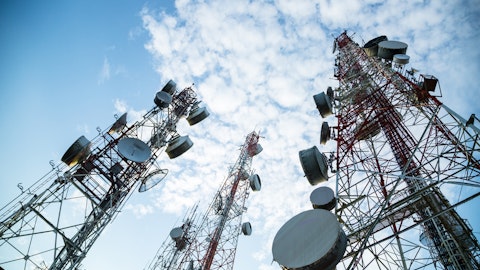Meanwhile, the company’s data center business has been a disappointment thanks to constant price wars with the likes of Amazon Web Services and Alphabet’s Google. In fact, management is now looking to sell the data center business, whose EBITDA margins are about half that of its consumer businesses.
While such a move would certainly help boost profitability going forward, it would also mean the loss of about 20% of the company’s revenue. This, in turn, would mean even less future cash flow with which to fund its high capital spending needs.
Overall, Centurylink Inc (NYSE:CTL) looks like a business that is struggling just to tread water. Close to half of its business is growing, but the other half is shrinking. Unfortunately, the growing half carries below average margins, compressing long-term profitability as CenturyLink’s legacy cash cow slowly dries up.
Judging from the company’s costly and largely unsuccessful move into cloud computing several years ago, management’s capital allocation skill should certainly be questioned as well. In my view, these actions reek of desperation as CenturyLink’s legacy markets are declining faster than the company can find new, profitable opportunities for sustainable growth.
Key Risks
There are several risks facing CenturyLink and its dividend which, in my view, make the shares a “pass.”
First, CenturyLink’s legacy landline phone business is beyond saving and will almost certainly continue to decline. As it does so, it faces the problems of reverse economies of scale.
In other words, the company needs to maintain its copper phone lines in order for any customers to be able to have service. However, as more and more customers cancel their service, this segment’s margins will deteriorate and eventually turn negative, ultimately forcing the company to completely discontinue it down the road.
The problem is that landline phone service is a regulated utility and requires states to pass laws allowing telcos such as CenturyLink to discontinue such services. This means that there is always the risk that, in the future, the company will be forced by regulators to continue offering an obsolete service that’s bringing in almost no revenue but consuming precious and scarce capital that is needed for its struggling internet business.
Speaking of regulators, don’t forget that the businesses in which CenturyLink operates are heavily regulated by the FCC. This means there is the ever present risk that changes in regulations can lead to lower sales, and margins. For example, the FCC is now considering changes to regulations affecting business data services, which could lead to even greater competition from the likes of AT&T and Verizon for the company’s struggling revenues.
And we can’t forget that back in June of 2016 the FCC officially declared its ability to regulate internet service providers such as CenturyLink, in order to enforce net neutrality. In a joint statement with fellow rural ISPs Frontier Communications (FTR) and Fairpoint, CenturyLink warned that “regulatory rate reductions for broadband data services in the highest cost areas will prevent or slow competitive growth and make it difficult for current providers to continue with planned upgrades and future investments.”
In other words, in the future CenturyLink faces the risk of both negative regulatory decisions that could hit its top and bottom lines from both its legacy, dying landline business and its bread and butter internet service division.
But of course the company’s largest risk comes from competition from both cable companies such as Comcast, and Charter Communications, Inc. (NASDAQ:CHTR), as well as wireless providers AT&T and Verizon, both of which also compete with CenturyLink in the ISP arena.
Worse yet, 5G, the next generation of wireless technology, could prove to pose an existential risk to the company. That’s because 5G wireless will allow what Verizon has dubbed “Wireless Broadband,” a way of providing ultra-fast internet through the air, and thus making CenturyLink’s 250,000 miles of buried cables pretty much obsolete.
It’s not just deep pocketed Verizon that’s hoping to disrupt the internet business with 5G. AT&T is currently testing “Project AirGig,” which AT&T’s Chief Strategy Officer John Donovan says “has tremendous potential to transform internet access globally – well beyond our current broadband footprint and not just in the United States.”
Specifically AirGig would allow AT&T to offer fiber optic-like internet speeds though next gen wireless tech fitted onto its own existing utility poles.
This potentially breakthrough technology, backed by some of the richest corporations on earth, is something that the much smaller CenturyLink simply couldn’t compete with. Of course, these technology developments are filled with plenty of their own risks and will likely take many years to rollout.
CenturyLink investors also need to be aware of rising interest rates. Any interest rate increase would prove costly for CenturyLink, which has a total debt load of approximately $20 billion.
Worse yet, because CenturyLink doesn’t have an investment grade credit rating, its average debt cost is a high 6.6%; a figure that will only climb along with interest rates, and one not shared by investment grade rivals.



